Dynamic Replacement of Soil Inorganic Carbon under Water Erosion
Abstract
1. Introduction
2. Materials and Methods
2.1. Study Area
2.2. Methods
2.3. Data Sources and Processing
2.3.1. WaTEM/SEDEM Model Use Data
2.3.2. Observed Data
Soil Samples
Carbon Isotope Determination in Water Samples
Carbon Isotope Determination in Soil Samples and Vegetation Cover Survey
2.4. Statistical Analysis
3. Results
3.1. Dynamic Replacement of Soil Carbon under Water Erosion
3.2. Soil Erosion and Soil Carbon Relationship
3.3. Soil and River Carbon Fraction Characterization
4. Discussion
4.1. Dynamic Replacement Mechanisms of Soil Inorganic Carbon
4.2. Implications of Dynamic Replacement of Soil Inorganic Carbon under Water Erosion for the Modern Carbon Cycle
4.3. Assessment of Water Erosion and Regional Carbon Sinks
5. Conclusions
Supplementary Materials
Author Contributions
Funding
Data Availability Statement
Acknowledgments
Conflicts of Interest
References
- Battin, T.J.; Lauerwald, R.; Bernhardt, E.S.; Bertuzzo, E.; Gener, L.G.; Hall, R.O.; Hotchkiss, E.R.; Maavara, T.; Pavelsky, T.M.; Ran, L.; et al. River ecosystem metabolism and carbon biogeochemistry in a changing world. Nature 2023, 613, 449–459. [Google Scholar] [CrossRef]
- Quinton, J.N.; Govers, G.; Van Oost, K.; Bardgett, R.D. The impact of agricultural soil erosion on biogeochemical cycling. Nat. Geosci. 2010, 3, 311–314. [Google Scholar] [CrossRef]
- Regnier, P.; Friedlingstein, P.; Ciais, P.; Mackenzie, F.T.; Gruber, N.; Janssens, I.A.; Laruelle, G.G.; Lauerwald, R.; Luyssaert, S.; Andersson, A.J.; et al. Anthropogenic perturbation of the carbon fluxes from land to ocean. Nat. Geosci. 2013, 6, 597–607. [Google Scholar] [CrossRef]
- Cole, J.J.; Prairie, Y.T.; Caraco, N.F.; McDowell, W.H.; Tranvik, L.J.; Striegl, R.G.; Duarte, C.M.; Kortelainen, P.; Downing, J.A.; Middelburg, J.J.; et al. Plumbing the global carbon cycle: Integrating inland waters into the terrestrial carbon budget. Ecosystems 2007, 10, 172–185. [Google Scholar] [CrossRef]
- Battin, T.J.; Luyssaert, S.; Kaplan, L.A.; Aufdenkampe, A.K.; Richter, A.; Tranvik, L.J. The boundless carbon cycle. Nat. Geosci. 2009, 2, 598–600. [Google Scholar] [CrossRef]
- Tranvik, L.J.; Downing, J.A.; Cotner, J.B.; Loiselle, S.A.; Striegl, R.G.; Ballatore, T.J.; Dillon, P.; Finlay, K.; Fortino, K.; Knoll, L.B.; et al. Lakes and reservoirs as regulators of carbon cycling and climate. Limnol. Oceanogr. 2009, 54, 2298–2314. [Google Scholar] [CrossRef]
- Bastviken, D.; Tranvik, L.J.; Downing, J.A.; Crill, P.M.; Enrich-Prast, A. Freshwater methane emissions offset the continental carbon sink. Science 2011, 331, 50. [Google Scholar] [CrossRef] [PubMed]
- Raymond, P.A.; Hartmann, J.; Lauerwald, R.; Sobek, S.; McDonald, C.; Hoover, M.; Butman, D.; Striegl, R.; Mayorga, E.; Humborg, C.; et al. Global carbon dioxide emissions from inland waters. Nature 2013, 503, 355–359. [Google Scholar] [CrossRef] [PubMed]
- Borges, A.V.; Morana, C.; Bouillon, S.; Servais, P.; Descy, J.P.; Darchambeau, F. Carbon cycling of Lake Kivu (East Africa): Net autotrophy in the epilimnion and emission of CO2 to the atmosphere sustained by geogenic inputs. PLoS ONE 2014, 9, e109500. [Google Scholar] [CrossRef] [PubMed][Green Version]
- Friedlingstein, P.; O’sullivan, M.; Jones, M.W.; Andrew, R.M.; Gregor, L.; Hauck, J.; Quéré, C.L.; Luijkx, I.T.; Olsen, A.; Peters, G.P.; et al. Global carbon budget 2022. Earth Syst. Sci. Data 2022, 14, 4811–4900. [Google Scholar] [CrossRef]
- Berner, R. A combined model for Phanerozoic atmospheric O2 and CO2. Geochim. Cosmochim. Acta 2006, 70, 5653–5664. [Google Scholar] [CrossRef]
- Walker, J.; Hays, P.; Kasting, J. A Negative feedback mechanism for the long-term stabilization of Earths surface-temperature. J. Geophys. Res. Atmos. 1981, 86, 9776–9782. [Google Scholar] [CrossRef]
- Beaulieu, E.; Goddéris, Y.; Donnadieu, Y.; Labat, D.; Roelandt, C. High sensitivity of the continental-weathering carbon dioxide sink to future climate change. Nat. Clim. Chang. 2012, 2, 346–349. [Google Scholar] [CrossRef]
- Ciais, P.; Sabine, C.; Bala, G.; Bopp, L.; Brovkin, V.; Canadell, J.; Chhabra, A.; DeFries, R.; Galloway, J.; Heimann, M.; et al. Carbon and Other Biogeochemical Cycles, 3rd ed.; Cambridge University Press: Cambridge, UK, 2013; pp. 465–570. [Google Scholar]
- Pu, J.B.; Jiang, Z.C.; Yuan, D.X.; Zhang, C. Some opinions on rock-weathering-related carbon sink from the IPCC Fifth assessment Report. Adv. Earth Sci. 2015, 30, 1081–1090. [Google Scholar]
- Van Oost, K.; Quine, T.A.; Govers, G.; De Gryze, S.; Six, J.; Harden, J.W.; Ritchie, J.C.; McCarty, G.W.; Heckrath, G.; Kosmas, C.; et al. The impact of agricultural soil erosion on the global carbon cycle. Science 2007, 318, 626–629. [Google Scholar] [CrossRef] [PubMed]
- Yue, Y.; Ni, J.; Ciais, P.; Piao, S.; Wang, T.; Huang, M.; Borthwick, A.G.L.; Li, T.; Wang, Y.; Chappell, A. Lateral transport of soil carbon and land−atmosphere CO2 flux induced by water erosion in China. Proc. Natl. Acad. Sci. USA 2016, 113, 6617–6622. [Google Scholar] [CrossRef] [PubMed]
- Lal, R. Soil degradation by erosion. Land Degrad. Dev. 2001, 12, 519–539. [Google Scholar] [CrossRef]
- Lal, R.; Griffin, M.; Apt, J.; Lave, L.; Morgan, M.G. Managing soil carbon. Science 2004, 304, 393. [Google Scholar] [CrossRef] [PubMed]
- Lugato, E.; Paustian, K.; Panagos, P.; Jones, A.; Borrelli, P. Quantifying the erosion effect on current carbon budget of European agricultural soils at high spatial resolution. Glob. Chang. Biol. 2016, 22, 1976–1984. [Google Scholar] [CrossRef]
- Berhe, A.A.; Harte, J.; Harden, J.W.; Torn, M.S. The significance of the erosion-induced terrestrial carbon sink. Bioscience 2007, 57, 337–346. [Google Scholar] [CrossRef]
- Stallard, R. Terrestrial sedimentation and the carbon cycle: Coupling weathering and erosion to carbon burial. Glob. Biogeochem. Cycles 1998, 12, 231–257. [Google Scholar] [CrossRef]
- Haregeweyn, N.; Poesen, J.; Verstraeten, G.; Govers, G.; Moeyersons, J. Assessing the performance of a spatially distributed soil erosion and sediment delivery model (watem/sedem) in northern ethiopia. Land Degrad. Dev. 2013, 24, 188–204. [Google Scholar] [CrossRef]
- Yoo, K.; Amundson, R.; Heimsath, A.M.; Dietrich, W.E. Erosion of upland hillslope soil organic carbon: Coupling field measurements with a sediment transport model. Glob. Biogeochem. Cycles 2005, 19, 1–17. [Google Scholar] [CrossRef]
- Smith, S.; Sleezer, R.O.; Renwick, W.H.; Buddemeier, R.W. Fates of eroded soil organic carbon: Mississippi basin case study. Ecol. Appl. 2005, 15, 1929–1940. [Google Scholar] [CrossRef]
- Smith, S.V.; Renwick, W.H.; Buddenmeier, R.W.; Crossland, C.J. Budgets of soil erosion and deposition for sediments and sedimentary organic carbon across the conterminous United States. Glob. Biogeochem. Cycles 2001, 15, 697–707. [Google Scholar] [CrossRef]
- Lal, R. Soil erosion and the global carbon budget. Environ. Int. 2003, 29, 437–450. [Google Scholar] [CrossRef] [PubMed]
- Schlesinger, W.H.; Belnap, J.; Marion, G. On carbon sequestration in desert ecosystems. Glob. Chang. Biol. 2009, 15, 1488–1490. [Google Scholar] [CrossRef]
- Wang, C.; Wang, X.; Liu, D.; Wu, H.; Lü, X.; Fang, Y.; Cheng, W.; Luo, W.; Jiang, P.; Shi, J.; et al. Aridity threshold in controlling ecosystem nitrogen cycling in arid and semi-arid grasslands. Nat. Commun. 2014, 5, 4799. [Google Scholar] [CrossRef] [PubMed]
- An, H.; Wu, X.; Zhang, Y.; Tang, Z. Effects of land-use change on soil inorganic carbon: A meta-analysis. Geoderma 2019, 353, 273–282. [Google Scholar] [CrossRef]
- Suarez, D.L. Inorganic carbon: Land use impacts. In Encyclopedia of Soil Science, 2nd ed.; Lal, R., Ed.; CRC Press: Boca Raton, FL, USA, 2005; pp. 895–897. [Google Scholar]
- Monger, H.C.; Gallegos, R.A. Biotic and abiotic processes and rates of pedogenic carbonate accumulation in the Southwestern United States–relationship to atmospheric CO2 sequestration. In Global Climate Change and Pedogenic Carbonates; Lal, R., Kimble, J.M., Eswaran, H., Stewart, B.A., Eds.; Lewis Publishers: Boca Raton, FL, USA, 2000; pp. 273–289. [Google Scholar]
- Zamanian, K.; Pustovoytov, K.; Kuzyakov, Y. Pedogenic carbonates: Forms and formation processes. Earth-Sci. Rev. 2016, 157, 1–17. [Google Scholar] [CrossRef]
- Wang, Y.; Wang, Z.; Li, Y. Storage/turnover rate of inorganic carbon and its dissolvable part in the profile of saline/alkaline soils. PLoS ONE 2013, 8, e82029. [Google Scholar] [CrossRef] [PubMed]
- Borrelli, P.; Oost, K.V.; Meusburger, K.; Alewell, C.; Lugato, E.; Panagos, P. A step towards a holistic assessment of soil degradation in europe: Coupling on-site erosion with sediment transfer and carbon fluxes. Environ. Res. 2018, 161, 291–298. [Google Scholar] [CrossRef] [PubMed]
- Van Rompaey, A.J.J.; Verstraeten, G.; Van Oost, K.; Govers, G.; Poesen, J. Modelling mean annual sediment yield using a distributed approach. Earth Surf. Process. Landforms 2001, 26, 1221–1236. [Google Scholar] [CrossRef]
- Verstraeten, G.; Van Oost, K.; Van Rompaey, A.; Poesen, J.; Govers, G. Evaluating an integrated approach to catchment management to reduce soil loss and sediment pollution through modelling. Soil Use Manag. 2002, 19, 386–394. [Google Scholar] [CrossRef]
- Verstraeten, G.; Prosser, I.P.; Fogarty, P. Predicting the spatial patterns of hillslope sediment delivery to river channels in the Murrumbidgee catchment. Aust. J. Hydrol. 2007, 334, 440–454. [Google Scholar] [CrossRef]
- Alatorre, L.C.; Beguería, S.; García-Ruiz, J.M. Regional scale modeling of hillslope sediment delivery: A case study in the barasona reservoir watershed (spain) using watem/sedem. J. Hydrol. 2010, 391, 109–123. [Google Scholar] [CrossRef]
- Fang, H. Impact of land use change and dam construction on soil erosion and sediment yield in the black soil region, northeastern china. Land Degrad. Dev. 2017, 28, 1482–1492. [Google Scholar] [CrossRef]
- Krasa, J.; Dostal, T.; Jachymova, B.; Bauer, M.; Devaty, J. Soil erosion as a source of sediment and phosphorus in rivers and reservoirs—Watershed analyses using watem/sedem. Environ. Res. 2019, 171, 470–483. [Google Scholar] [CrossRef] [PubMed]
- Villuendas, I.L.; Latorre, B.; Gaspar, L.; Navas, A. Effect of historical land-use change on soil erosion in a mediterranean catchment by integrating 137Cs measurements and watem/sedem model. Hydrol. Process. 2022, 36, e14577. [Google Scholar] [CrossRef]
- Tang, X.; Zhao, X.; Bai, Y.; Tang, Z.; Wang, W.; Zhao, Y.; Zhou, G. Carbon pools in China’s terrestrial ecosystems: New estimates based on an intensive field survey. Proc. Natl. Acad. Sci. USA 2018, 115, 4021–4026. [Google Scholar] [CrossRef]
- Wang, S.Q.; Zhou, C.H.; Li, K.R.; Zhu, S.L.; Huang, F.H. Analysis on Spatial Distribution Characteristics of Soil Organic Carbon Reservoir in China. Acta Geogr. Sin. 2000, 67, 533–544. [Google Scholar]
- Deng, L.; Liu, G.B.; Shangguan, Z.P. Land-use conversion and changing soil carbon stocks in China’s ‘grain-for-Green’Program: A synthesis. Glob. Chang. Biol. 2014, 20, 3544–3556. [Google Scholar] [CrossRef] [PubMed]
- Yang, Y.; Liu, L.; Zhang, P.; Wu, F.; Wang, Y.; Xu, C.; Kuzyakov, Y. Large-scale ecosystem carbon stocks and their driving factors across Loess Plateau. Carbon Neutrality 2023, 2, 5. [Google Scholar] [CrossRef]
- Zheng, S.X.; Shangguan, Z. Variation in the δ13C value of typical plants of loess plateau over the last 70 years. Chin. J. Plant Ecol. 2005, 29, 289–295. [Google Scholar] [CrossRef]
- Zheng, S.; Shangguan, Z. Spatial patterns of foliar stable carbon isotope compositions of C3 plant species in the Loess Plateau of China. Ecol. Res. 2007, 22, 342–353. [Google Scholar] [CrossRef]
- Mackensen, A.; Schmiedl, G. Stable carbon isotopes in paleoceanography: Atmosphere, oceans, and sediments. Earth-Sci. Rev. 2019, 197, 102893. [Google Scholar] [CrossRef]
- Sun, J.; Takahashi, Y.; Strosnider, W.H.J.; Kogure, T.; Wu, P.; Cao, X. Tracing and quantifying contributions of end members to karst water at a coalfield in southwest China. Chemosphere 2019, 234, 777–788. [Google Scholar] [CrossRef] [PubMed]
- Cai, C.F.; Ding, S.W.; Shi, Z.H.; Huang, L. Study of applying USLE and geographical information system IDRISI to predict soil erosion in small watershed. Sci. Soil Water Conserv. 2000, 14, 19–24. [Google Scholar]
- Williams, H.R.; Renard, K.G.; Dyke, P.T. EPIC: A new method for assessing erosion’s effect on soil productivity. J. Soll Water Conserv. 1983, 38, 381–383. [Google Scholar]
- Xie, X.L.; Sun, B.; Zhou, H.Z.; Li, Z.P.; Li, A.B. Organic carbon density and storage in soils of China and spatial analysis. Acta Pedol. Sin. 2004, 41, 35–43. [Google Scholar]
- Zhang, W.B.; Zhao, Y.; Liu, B.Y. Rainfall erosivity estimation using daily rainfall amounts. Sci. Geogr. Sin. 2002, 22, 705–711. [Google Scholar]
- Yang, Z.S. Study on soil loss equation in Jinsha River Basin of Yunnan Province. J. Mt. Sci. 2002, 20, 1–9. [Google Scholar]
- Chen, J.; Li, Z.; Xiao, H.; Ning, K.; Tang, C. Effects of land use and land cover on soil erosion control in southern China: Implications from a systematic quantitative review. J. Environ. Manag. 2021, 282, 111924. [Google Scholar] [CrossRef]
- SL190-2007; Standards for Classification and Gradation of Soil Erosion. Ministry of Water Resources of the People’s Republic of China: Beijing, China, 2008.
- Liu, J.; Fa, K.; Zhang, Y.; Wu, B.; Qin, S.; Jia, X. Abiotic CO2 uptake from the atmosphereby semiarid desert soil and its partitioning into soil phases. Geophys. Res. Lett. 2015, 42, 5779–5785. [Google Scholar] [CrossRef]
- Ma, J.; Liu, R.; Tang, L.S.; Lan, Z.D.; Li, Y. A downward CO2 flux seems to have nowhere to go. Biogeosciences 2014, 11, 6251–6262. [Google Scholar] [CrossRef]
- Li, Y.; Wang, Y.; Tang, L. The Effort to Re-Activate the Inorganic Carbon in Soil. Acta Pedol. Sin. 2016, 53, 845–849. [Google Scholar]
- Marx, A.; Dusek, J.; Jankovec, J.; Sanda, M.; Vogel, T.; van Geldern, R.; Hartmann, J.; Barth, J.A.C. A review of CO2 and associated carbon dynamics in headwater streams: A global perspective. Rev. Geophys. 2017, 55, 560–585. [Google Scholar] [CrossRef]
- Sobek, S.; Tranvik, L.J.; Prairie, Y.T.; Kortelainen, P.; Cole, J.J. Patterns and regulation of dissolved organic carbon: An analysis of 7,500 widely distributed lakes. Limnol. Oceanogr. 2007, 52, 1208–1219. [Google Scholar] [CrossRef]
- Stone, R. Have desert researchers discovered a hidden loop in the carbon cycle? Science 2008, 320, 1409–1410. [Google Scholar] [CrossRef]
- Ma, J.; Wang, Z.Y.; Stevenson, B.A.; Zheng, X.J.; Li, Y. An inorganic CO2 diffusion and dissolution process explains negative CO2 fluxes in saline/alkaline soils. Sci. Rep. 2013, 3, 2025. [Google Scholar] [CrossRef]
- Hamerlynck, E.P.; Scott, R.L.; Sánchez-Cañete, E.P.; Barron-Gafford, G.A. Nocturnal soil CO2 uptake and its relationship to subsurface soil and ecosystem carbon fluxes in a Chihuahuan Desert shrubland. J. Geophys. Res. Biogeosci. 2013, 118, 1593–1603. [Google Scholar] [CrossRef]
- Li, Y.; Wang, Y.G.; Houghton, R.A.; Tang, L.-S. Hidden carbon sink beneath desert. Geophys. Res. Lett. 2015, 42, 5880–5887. [Google Scholar] [CrossRef]
- Kateb, H.E.; Zhang, H.; Zhang, P.; Mosandl, R. Soil erosion and surface runoff on different vegetation covers and slope gradients: A field experiment in Southern Shaanxi Province, China. Catena 2013, 105, 1–10. [Google Scholar] [CrossRef]
- Ruiz-Colmenero, M.; Bienes, R.; Eldridge, D.J.; Marques, M. Vegetation cover reduces erosion and enhances soil organic carbon in a vineyard in the central Spain. Catena 2013, 104, 153–160. [Google Scholar] [CrossRef]
- Liu, Z.; Dreybrodt, W.; Wang, H. A new direction in effective accounting for the atmospheric CO2 budget: Considering the combined action of carbonate dissolution, the global water cycle and photosynthetic uptake of DIC by aquatic organisms. Earth-Sci. Rev. 2010, 99, 162–172. [Google Scholar] [CrossRef]
- Wang, Z.; Hoffmann, T.; Six, J.; Kaplan, J.O.; Govers, G.; Doetterl, S.; Van Oost, K. Human-induced erosion has offset one-third ofcarbon emissions from land cover change. Nat. Clim. Chang. 2017, 7, 345–350. [Google Scholar] [CrossRef]
- Zhang, H.; Lauerwald, R.; Regnier, P.; Ciais, P.; Yuan, W.; Naipal, V.; Guenet, B.; Van Oost, K.; Camino-Serrano, M. Simulating erosion-induced soil and carbon delivery from uplands to rivers in a global land surface model. J. Adv. Model. Earth Syst. 2020, 12, e2020MS002121. [Google Scholar] [CrossRef]
- Liu, Y.; Wang, X.; Wang, Y.; Tong, C.; Yuan, W. Increased lateral transfer of soil organic carbon induced by climate and vegetation changes over the southeast coastal region of China. J. Geophys. Res. Biogeosci. 2019, 124, 3902–3915. [Google Scholar] [CrossRef]
- Li, X.; Wang, J.; Lin, J.; Yin, W.; Shi, Y.; Wang, L.; Xiao, H.; Zhong, Z.; Jiang, H.; Shi, Z. Hysteresis analysis reveals dissolved carbon concentration–discharge relationships during and between storm events. Water Res. 2022, 226, 119220. [Google Scholar] [CrossRef]
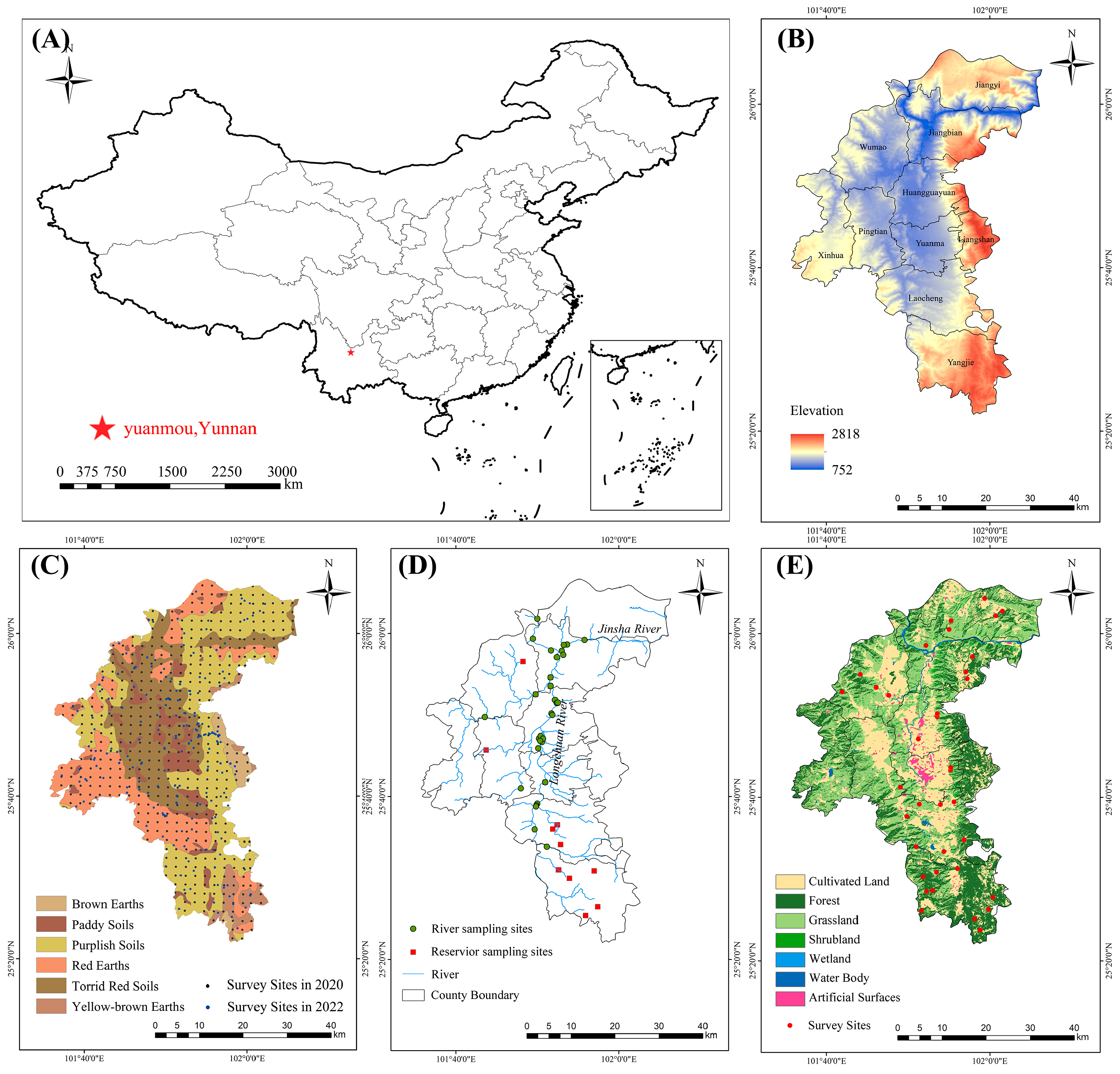
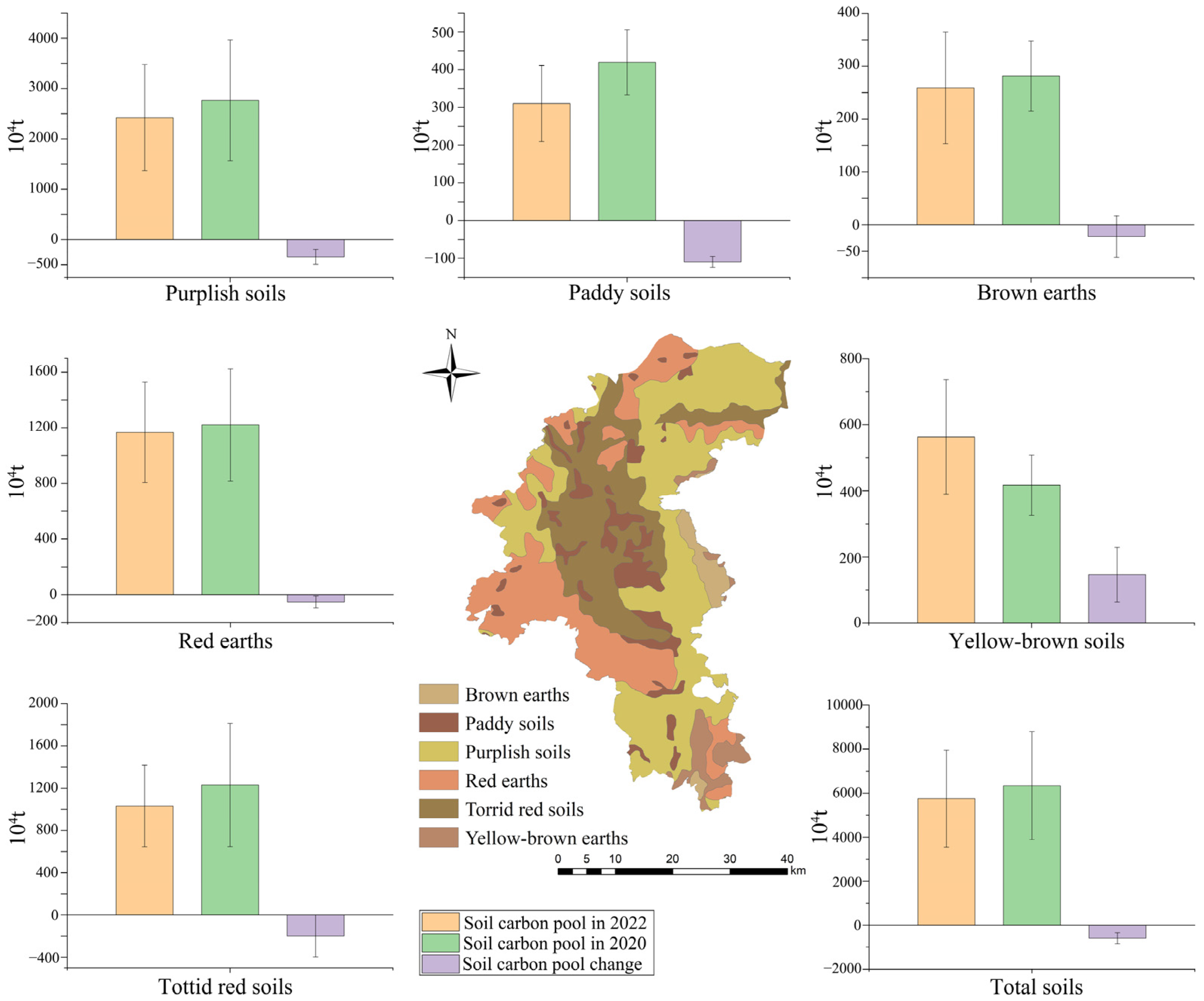
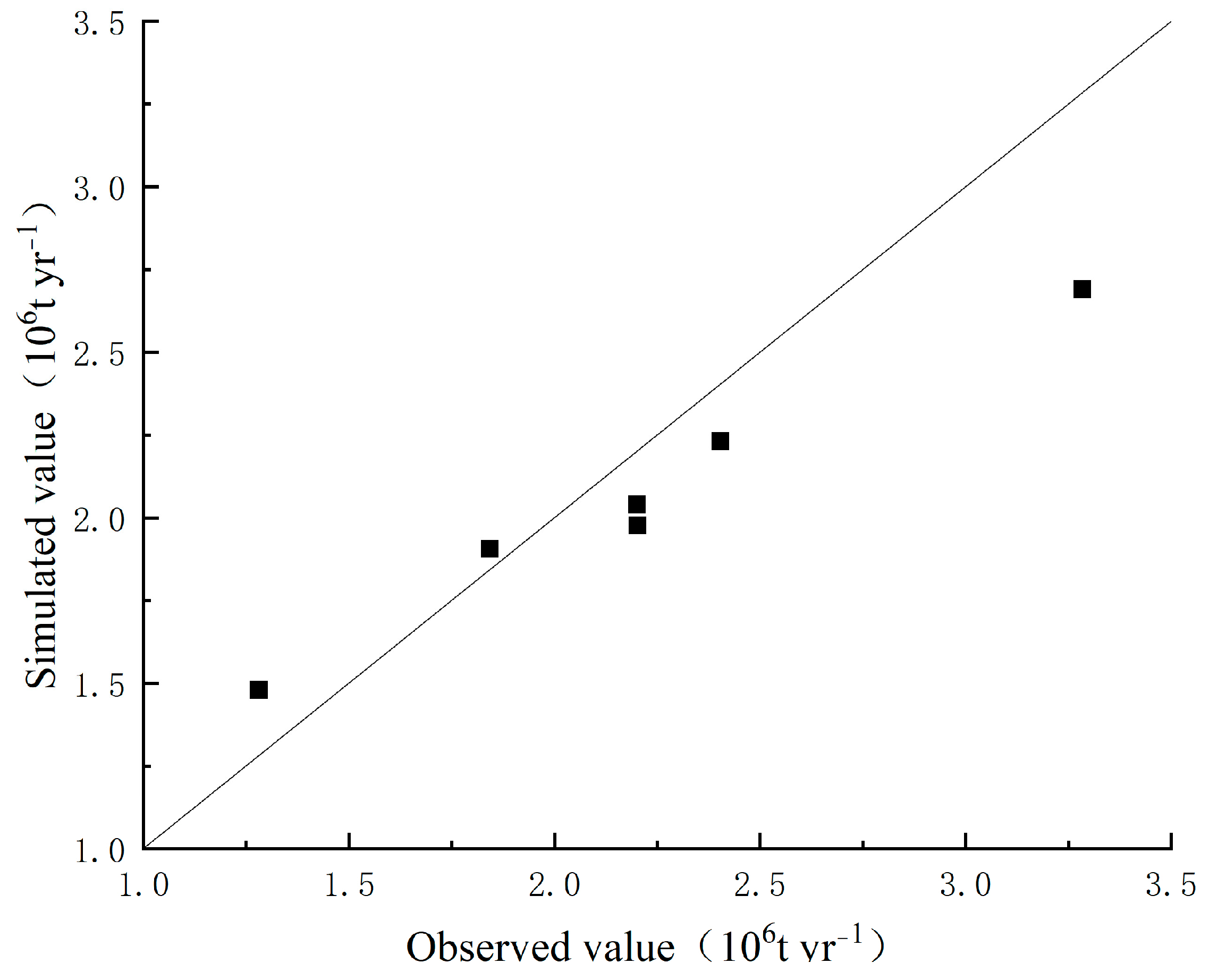
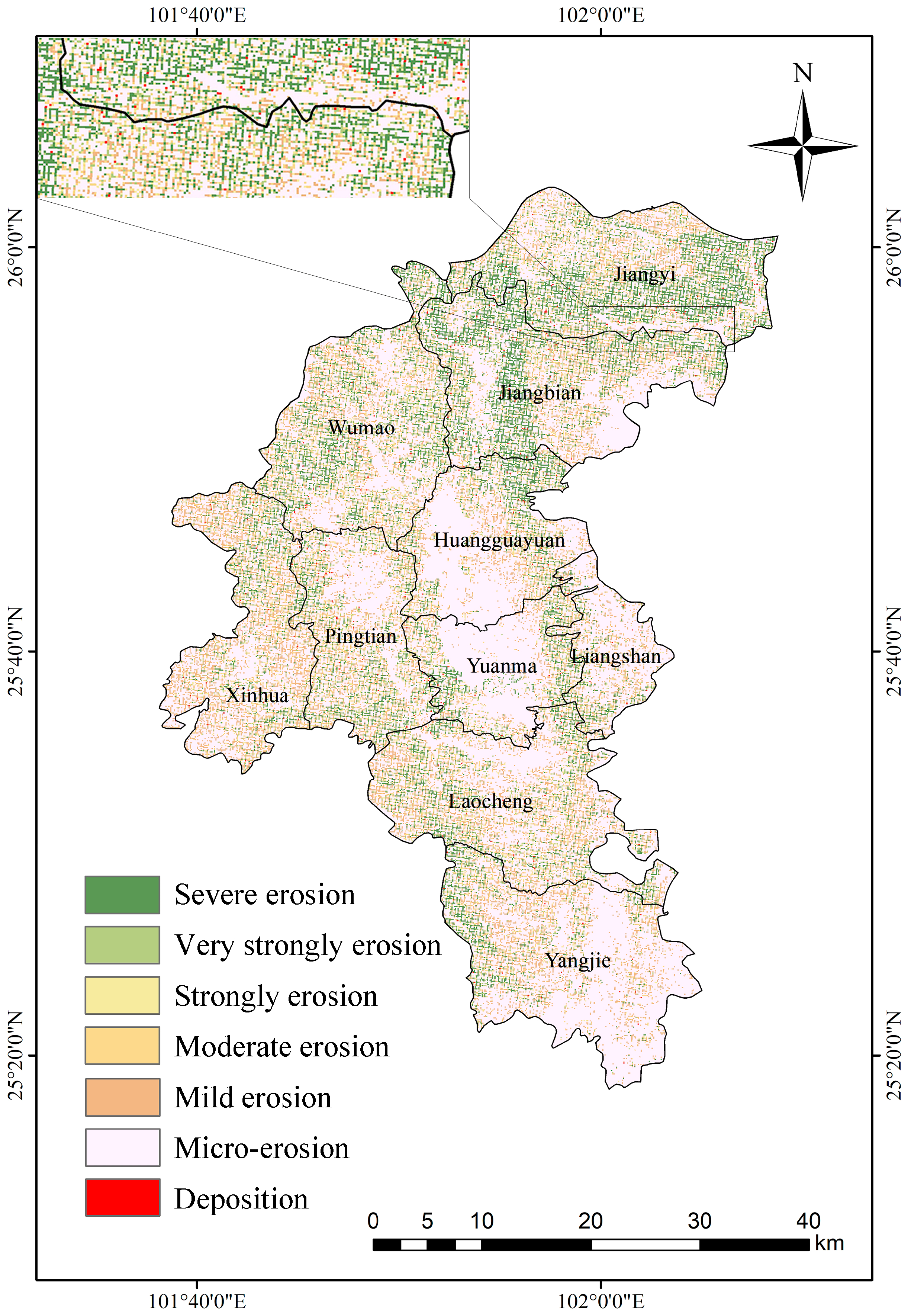
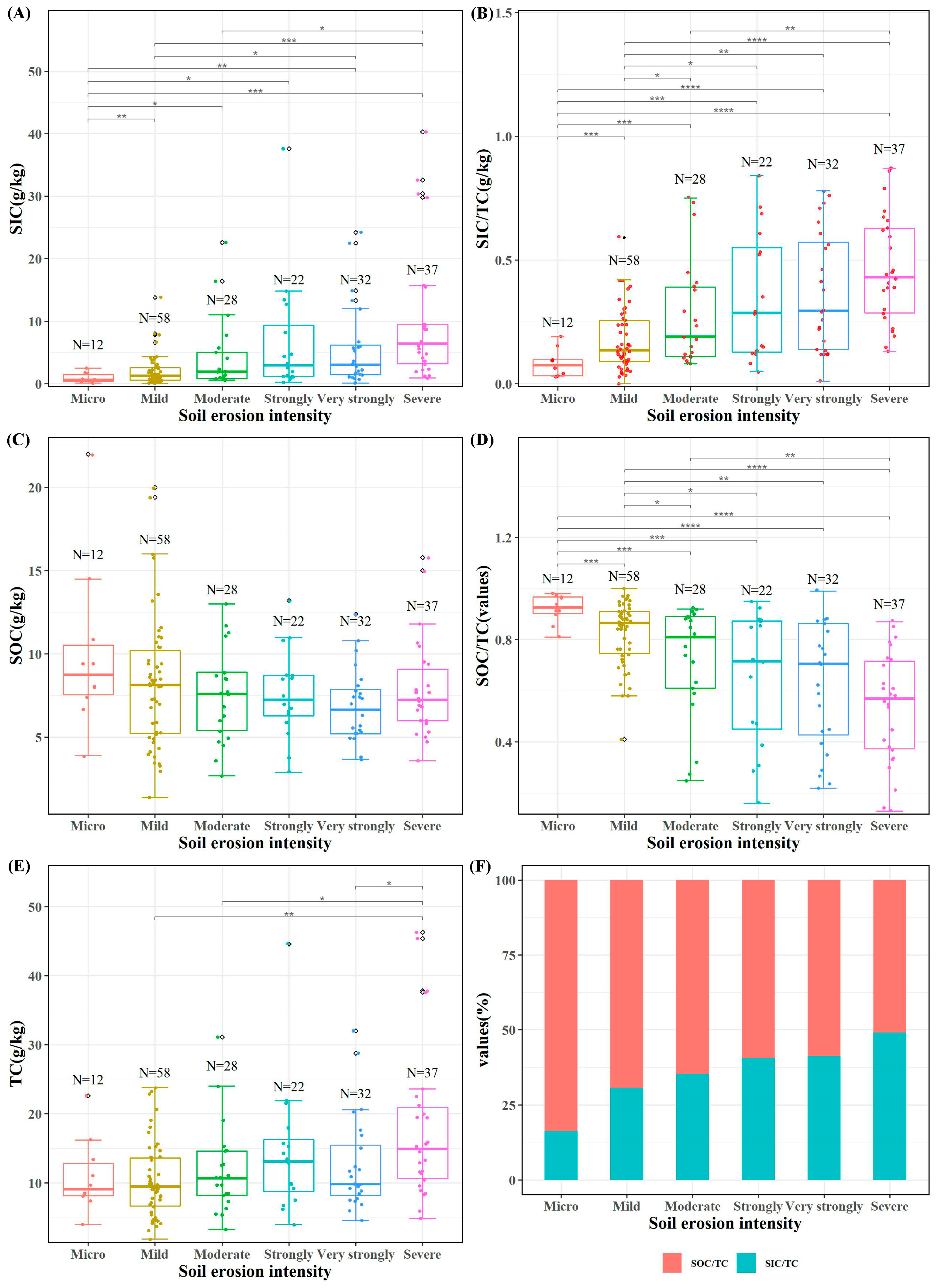
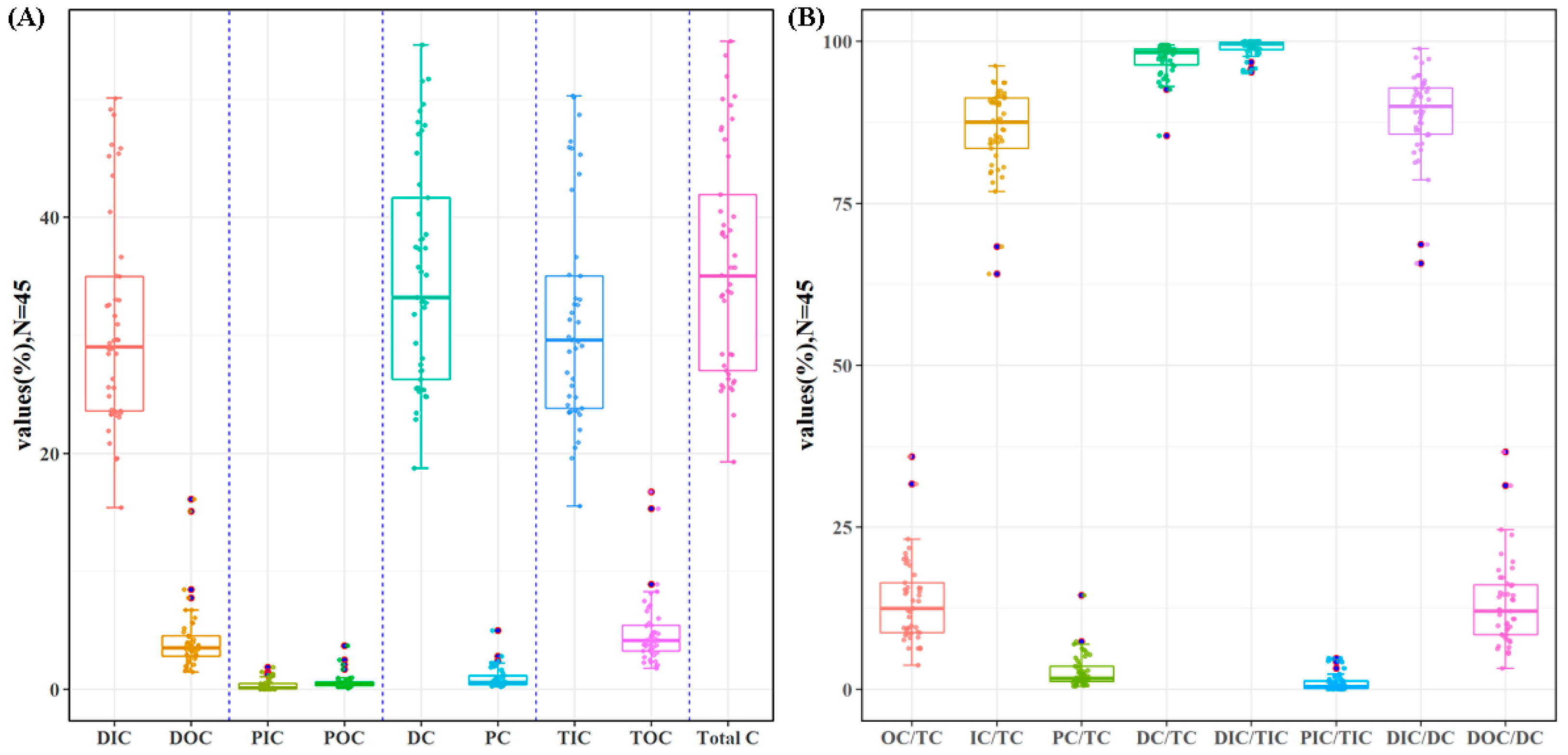
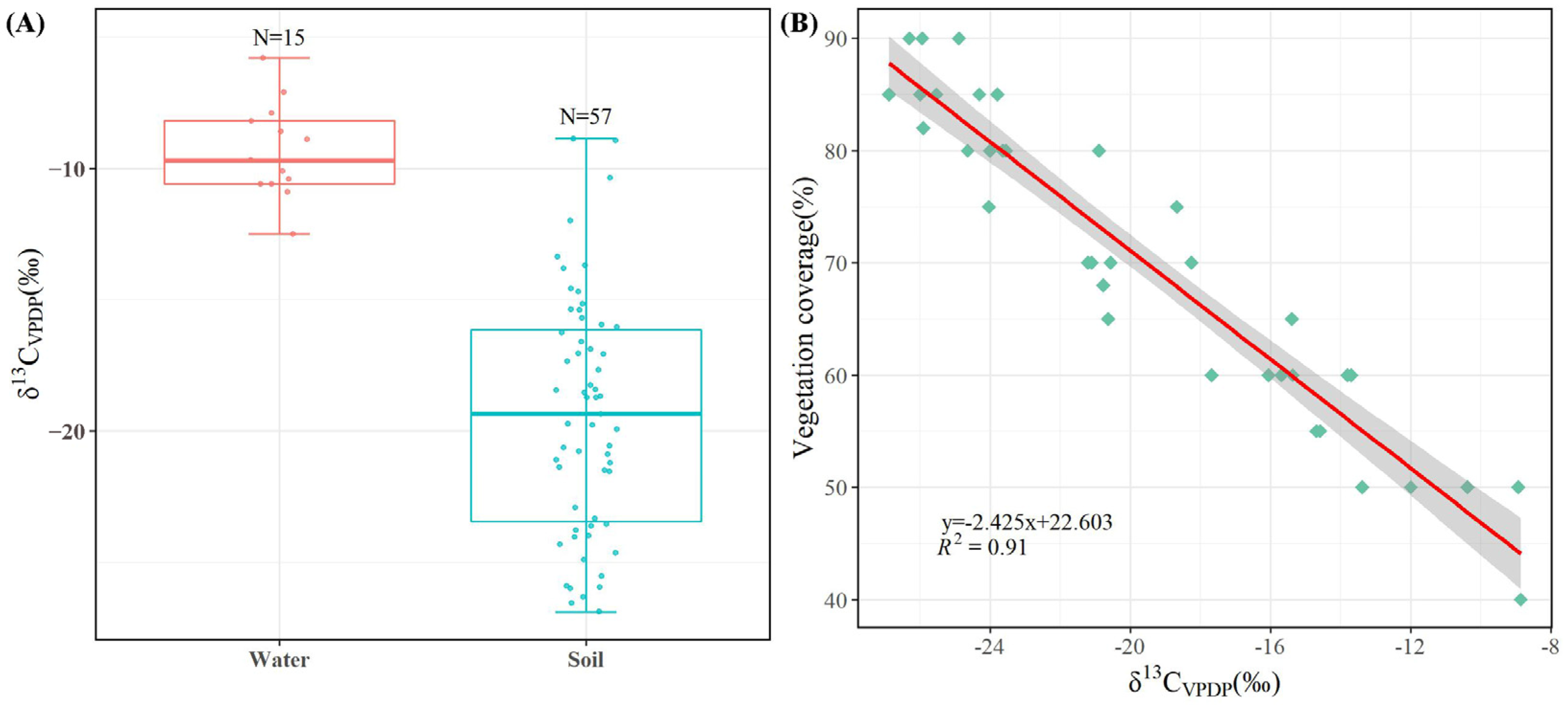

| Year | Observed Value (106t yr−1) | Simulated Value (106t yr−1) |
|---|---|---|
| 2003 | 3.28 | 2.69 |
| 2004 | 2.40 | 2.23 |
| 2005 | 1.84 | 1.91 |
| NS | 0.63 | |
| RMSE | 0.36 | |
| 2006 | 2.20 | 1.98 |
| 2007 | 1.28 | 1.48 |
| 2008 | 2.20 | 2.04 |
| NS | 0.79 | |
| RMSE | 0.2 | |
Disclaimer/Publisher’s Note: The statements, opinions and data contained in all publications are solely those of the individual author(s) and contributor(s) and not of MDPI and/or the editor(s). MDPI and/or the editor(s) disclaim responsibility for any injury to people or property resulting from any ideas, methods, instructions or products referred to in the content. |
© 2024 by the authors. Licensee MDPI, Basel, Switzerland. This article is an open access article distributed under the terms and conditions of the Creative Commons Attribution (CC BY) license (https://creativecommons.org/licenses/by/4.0/).
Share and Cite
Zhang, C.; Xu, C.; Huang, T.; Zhang, L.; Yang, J.; Chen, G.; Xu, X.; Zou, F.; Liu, Z.; Wang, Z. Dynamic Replacement of Soil Inorganic Carbon under Water Erosion. Land 2024, 13, 1053. https://doi.org/10.3390/land13071053
Zhang C, Xu C, Huang T, Zhang L, Yang J, Chen G, Xu X, Zou F, Liu Z, Wang Z. Dynamic Replacement of Soil Inorganic Carbon under Water Erosion. Land. 2024; 13(7):1053. https://doi.org/10.3390/land13071053
Chicago/Turabian StyleZhang, Chen, Can Xu, Tianbao Huang, Liankai Zhang, Jinjiang Yang, Guiren Chen, Xiongwei Xu, Fuyan Zou, Zihao Liu, and Zhenhui Wang. 2024. "Dynamic Replacement of Soil Inorganic Carbon under Water Erosion" Land 13, no. 7: 1053. https://doi.org/10.3390/land13071053
APA StyleZhang, C., Xu, C., Huang, T., Zhang, L., Yang, J., Chen, G., Xu, X., Zou, F., Liu, Z., & Wang, Z. (2024). Dynamic Replacement of Soil Inorganic Carbon under Water Erosion. Land, 13(7), 1053. https://doi.org/10.3390/land13071053






